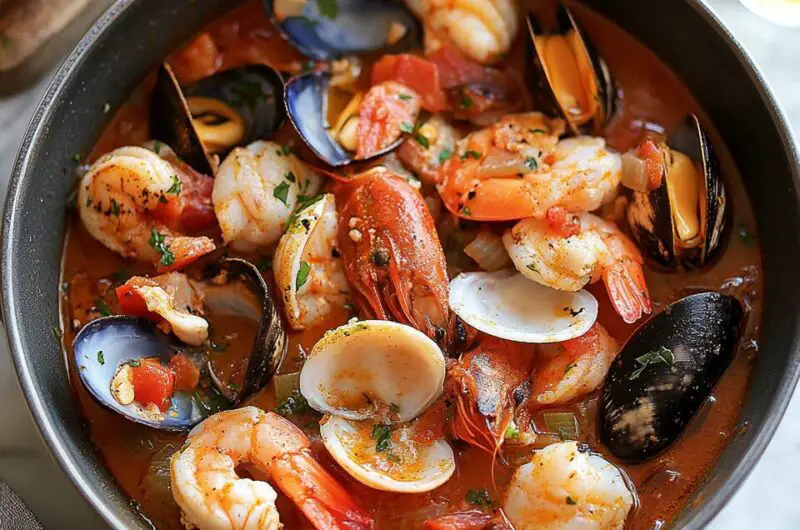Cioppino Seafood Stew is a comforting, tomato-based seafood dish that brings together the best of the ocean’s flavors. Originating from San Francisco, this dish features a savory broth infused with white wine, garlic, and herbs, perfectly complementing an array of fresh seafood like shrimp, mussels, clams, and white fish. The medley of flavors creates a rich and heartwarming experience that’s best enjoyed with a slice of crusty bread to soak up every last drop. What makes this dish so special is its adaptability. You can use whatever seafood you have on hand, making it an excellent choice for home cooks who love variety. Whether you’re serving it as a weeknight dinner or for a special occasion, Cioppino delivers a restaurant-quality meal that’s both impressive and easy to prepare. One spoonful of this flavorful broth, and you’ll be transported straight to the coastal kitchens of Italy!
Full Recipe:
Ingredients:
-
2 tbsp olive oil
-
1 small onion, diced
-
3 cloves garlic, minced
-
1/2 tsp red pepper flakes
-
1/2 cup dry white wine
-
1 can (14.5 oz) diced tomatoes
-
2 cups seafood or fish stock
-
1 cup clam juice
-
1 tsp dried oregano
-
1/2 tsp dried thyme
-
Salt and black pepper to taste
-
1/2 lb shrimp, peeled and deveined
-
1/2 lb mussels, scrubbed and debearded
-
1/2 lb clams, scrubbed
-
1/2 lb white fish (such as cod or halibut), cut into chunks
-
1/2 lb scallops
-
1 tbsp fresh parsley, chopped
-
1 tbsp fresh basil, chopped
-
Crusty bread, for serving
Directions:
-
Heat olive oil in a large pot over medium heat. Add the onion and cook until translucent, about 3 minutes.
-
Stir in garlic and red pepper flakes, cooking for another 1 minute until fragrant.
-
Pour in the white wine, scraping up any bits from the bottom of the pot, and let it simmer for 2 minutes.
-
Add diced tomatoes, seafood stock, clam juice, oregano, thyme, salt, and black pepper. Bring to a simmer and cook for 15 minutes to develop the flavors.
-
Add shrimp, mussels, clams, white fish, and scallops. Cover and let simmer for 5-7 minutes, or until the shellfish open and the fish is cooked through.
-
Discard any mussels or clams that do not open. Stir in fresh parsley and basil.
-
Serve hot with crusty bread for dipping.
Prep Time: 10 minutes | Cooking Time: 25 minutes | Total Time: 35 minutes
Kcal: 320 kcal | Servings: 4 servings
The Origins of Cioppino
Although cioppino may sound like a traditional Italian dish, it actually has its roots in the United States. It was created by Italian immigrant fishermen in San Francisco in the late 1800s. The dish was born out of necessity, as these fishermen would prepare a communal stew using the day’s fresh catch. They would often combine various seafood types with a tomato-based broth infused with wine, garlic, and herbs. Over time, cioppino became a beloved staple of San Francisco’s culinary scene and is now enjoyed worldwide.
Why Cioppino is Special
What makes cioppino so unique is its versatility. Unlike other seafood stews that require specific types of fish or shellfish, cioppino can be adapted based on availability. Whether you prefer shrimp, crab, mussels, or even lobster, the stew accommodates an array of seafood varieties. Additionally, the dish is relatively simple to prepare, making it an ideal choice for both home cooks and professional chefs.
The stew’s deep, layered flavor profile comes from the combination of fresh seafood, a well-seasoned tomato broth, and a splash of dry white wine. The acidity of the tomatoes enhances the natural sweetness of the seafood, while the wine adds depth and richness. A blend of herbs and spices further elevates the dish, making each spoonful a delightful medley of flavors.
The Role of Ingredients in Cioppino
Cioppino’s success lies in the quality of its ingredients. Each component contributes to the dish’s overall taste and texture.
- Seafood: A mix of shellfish and firm white fish is essential. The fresher the seafood, the better the flavor. Common choices include shrimp, mussels, clams, scallops, and cod.
- Tomatoes: The base of the stew relies on rich, ripe tomatoes, either fresh or canned. San Marzano tomatoes are often preferred due to their sweetness and low acidity.
- Wine: Dry white wine, such as Sauvignon Blanc or Pinot Grigio, adds a subtle acidity that enhances the stew’s depth.
- Garlic and Onions: These aromatics provide a robust flavor foundation.
- Herbs and Spices: Oregano, thyme, basil, and red pepper flakes bring warmth and complexity to the dish.
How to Serve Cioppino
Cioppino is traditionally served hot, with a side of crusty bread such as sourdough or baguette. The bread is perfect for soaking up the flavorful broth, ensuring that none of the delicious liquid goes to waste. Some people enjoy pairing cioppino with a glass of the same white wine used in the cooking process, enhancing the meal’s overall taste.
For a heartier meal, cioppino can be accompanied by a simple green salad or a light pasta dish. The goal is to complement the stew’s flavors without overpowering them.
Health Benefits of Cioppino
Cioppino is not only delicious but also packed with health benefits. Since it is primarily seafood-based, it is an excellent source of lean protein and essential nutrients.
- Rich in Omega-3 Fatty Acids: The seafood in cioppino provides a healthy dose of omega-3 fatty acids, which support heart health and brain function.
- Low in Calories: Unlike creamy chowders or heavy stews, cioppino is relatively low in calories while still being filling.
- Packed with Vitamins and Minerals: The tomatoes in the broth offer a good amount of vitamin C and lycopene, while the shellfish provide zinc, iron, and B vitamins.
- Good for Digestion: The combination of seafood and a light tomato broth makes cioppino easy to digest, making it a great choice for those looking for a satisfying yet light meal.
Tips for Making the Perfect Cioppino
While cioppino is relatively simple to prepare, a few tips can elevate it from good to exceptional.
Advertisement
- Use the Freshest Seafood Possible: The star of the dish is the seafood, so freshness is key. If you don’t have access to fresh seafood, high-quality frozen options can work as well.
- Don’t Overcook the Seafood: Overcooking can make shrimp rubbery and fish dry. Be mindful of cooking times to ensure a tender and flavorful result.
- Let the Broth Develop Flavor: Allow the tomato base to simmer for at least 15-20 minutes before adding the seafood. This helps the flavors meld together beautifully.
- Serve Immediately: Cioppino is best enjoyed fresh. If you need to reheat leftovers, do so gently over low heat to prevent the seafood from becoming tough.
- Pair with the Right Wine: If serving with wine, choose a crisp white wine such as Sauvignon Blanc, which complements the dish’s acidity and richness.
Variations of Cioppino
Though cioppino is already a versatile dish, there are several variations that cater to different tastes and dietary needs.
- Spicy Cioppino: Add extra red pepper flakes or fresh chili peppers for a fiery kick.
- Creamy Cioppino: Some versions incorporate a splash of heavy cream or coconut milk for a richer, silkier texture.
- Vegetarian Cioppino: While traditional cioppino is seafood-based, you can create a vegetarian version by using hearty vegetables like zucchini, mushrooms, and chickpeas.
- Cioppino with Pasta: Serve the stew over linguine or spaghetti for a heartier meal.
Conclusion:
Cioppino Seafood Stew is a dish that embodies comfort, tradition, and culinary craftsmanship. Whether you are a seafood lover or simply someone looking for a nutritious and flavorful meal, cioppino is a fantastic choice. Its rich history, versatile nature, and deeply satisfying taste make it a favorite among home cooks and restaurant chefs alike. With the right ingredients and a little patience, you can bring the essence of San Francisco’s famous seafood stew right into your own kitchen. So grab your freshest seafood, pour a glass of wine, and enjoy a steaming bowl of cioppino!








